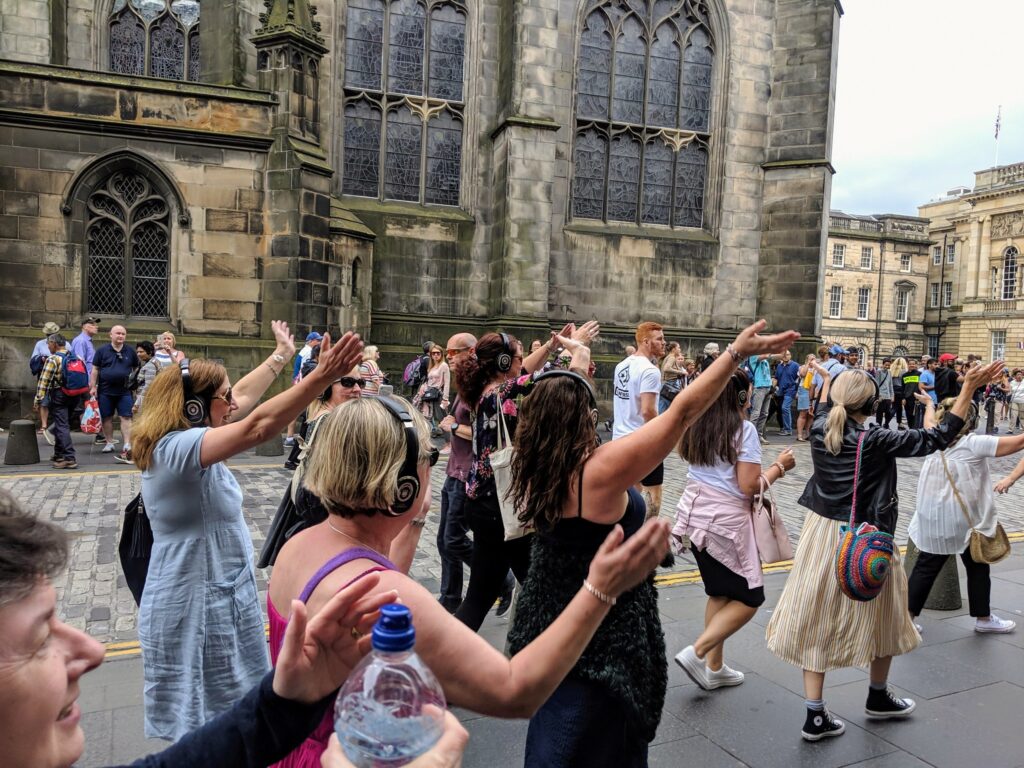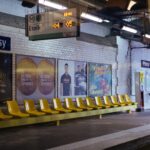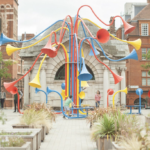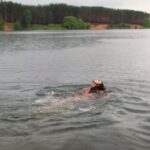(practice blog)
Headphones on… jazz is quietly playing; this is a rather pleasant sensory tour I thought. However, is my warm, private, isolated bubble about to burst? Yes, but in the most unexpected way! The soft jazz had lulled me into a false sense of security and what followed, much to my surprise, was an announcement that I was about to embark on a collective mission to bring disco to the streets of Edinburgh. In this blog I will explore my not-so-personal journey of breaking the conventionalities of headphone use in urban spaces and busting my personal auditory bubble.
Technology such as headphones, earphones and earbuds enable us to shut our ears away from the auditory sounds of the outside world, as we move through our everyday spaces (Bull, 2007b; De Silva, 2021). They generate a desire for solitude in public, where one can be “enclosed in our pleasurable and privatised sound bubbles” (Bull, 2007a, p.5). Bull (2007a, p.9) presents the concept of our urban environments being ‘chilly’ as in “distant and exclusive” whereas the private world of headphones is ‘warm’ and represents “the proximate, the inclusive”. Headphones allow users to “create islands of communicative warmth in oceans of urban chill” (Bull, 2007a, p.9).
Reluctantly the silent disco dancing and tentative singing began, choreographed via instructions from our leader and music blaring into my headphone ears. All the safety and comfort I usually experience when wearing headphones vanished and my sensory journey was becoming anything but private. Headphones can be seen as providing a “cloistered sanctuary”, allowing us to create our own private auditory experience (Klich, 2017, p.1). It is also suggested that headphones normally empower the auditory self (Bull, 2007b) but in this moment I felt the opposite, disempowered and out of control.

My usual headphone mediated self-isolation, where I had control over the urban space I was travelling through had exploded, I was now totally out of control and I was forced to blur the lines between my auditory self and the ‘other’. For the first few minutes my self-consciousness was acute, my heart raced, I tried not to listen to my instinct to retreat or withdraw back into my safe, warm solitary cocoon but there was no escape, the protection usually afforded by headphones was gone. Over the course of several streets, pop decades and various 70s disco moves, I settled and embraced my new very public role as street entertainer. By participating openly with the group and the outside world, I bought the warmth of my private music bubble, into the chill of the unconnected, isolated public space.
Using headphones in this manner broke all the standard rules of urban space, where the absence of shared sound is the norm and our replacement of it with singing and dancing disrupted these conventionalities and the primary purpose of headphones. I was forced to share my auditory experience with the outside world and encourage a connection between the public and private. This usually defined boundary was disrupted and towards the end of our sensory journey I came to appreciate the experience of blurring these lines and in doing so we transformed the surrounding urban sensory landscape.
While headphones usually separate us from the auditory world around us to create our own private world, this space is nonetheless very fragile requiring a balance between public and private sound environments (De Silva, 2021). In bursting the headphone bubble the sensory tour enabled me to experience isolation and togetherness, private and public, simultaneously.
References
Bull, M., 2007. An Introduction. Sound Moves: iPod Culture and Urban Experience (pp. 1-11) Routledge. (a)
Bull, M., 2007. Sound epistemologies: strategies and technologies. In Sound Moves: iPod Culture and Urban Experience (pp. 24-35). Routledge. (b)
De Silva, C.S., 2021. Private Sound Environments in Public Space: Use of Headphones in Public Parks and Public Transit(Doctoral dissertation, New Jersey Institute of Technology).
Klich, R., 2017. Amplifying sensory spaces: the in-and out-puts of headphone theatre. Contemporary Theatre Review, 27(3), pp.366-378.
Word Count: 578
(alljengi is licensed under CC BY-SA 2.0. )







